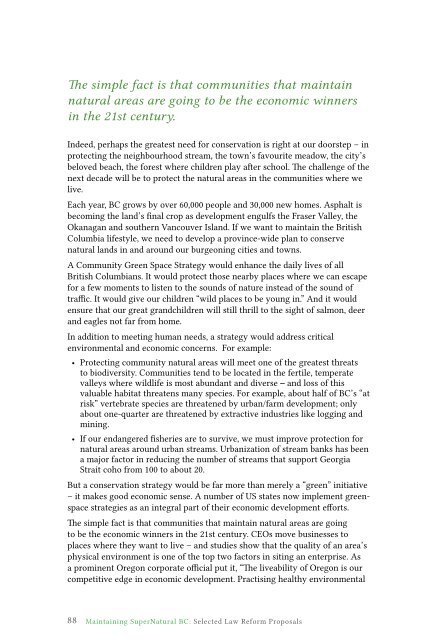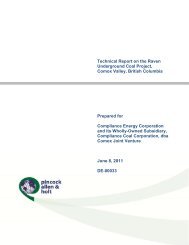Maintaining SuperNatural BC for Our Children - CoalWatch Comox ...
Maintaining SuperNatural BC for Our Children - CoalWatch Comox ...
Maintaining SuperNatural BC for Our Children - CoalWatch Comox ...
- No tags were found...
You also want an ePaper? Increase the reach of your titles
YUMPU automatically turns print PDFs into web optimized ePapers that Google loves.
The simple fact is that communities that maintainnatural areas are going to be the economic winnersin the 21st century.Indeed, perhaps the greatest need <strong>for</strong> conservation is right at our doorstep – inprotecting the neighbourhood stream, the town’s favourite meadow, the city’sbeloved beach, the <strong>for</strong>est where children play after school. The challenge of thenext decade will be to protect the natural areas in the communities where welive.Each year, <strong>BC</strong> grows by over 60,000 people and 30,000 new homes. Asphalt isbecoming the land’s final crop as development engulfs the Fraser Valley, theOkanagan and southern Vancouver Island. If we want to maintain the BritishColumbia lifestyle, we need to develop a province-wide plan to conservenatural lands in and around our burgeoning cities and towns.A Community Green Space Strategy would enhance the daily lives of allBritish Columbians. It would protect those nearby places where we can escape<strong>for</strong> a few moments to listen to the sounds of nature instead of the sound oftraffic. It would give our children “wild places to be young in.” And it wouldensure that our great grandchildren will still thrill to the sight of salmon, deerand eagles not far from home.In addition to meeting human needs, a strategy would address criticalenvironmental and economic concerns. For example:• Protecting community natural areas will meet one of the greatest threatsto biodiversity. Communities tend to be located in the fertile, temperatevalleys where wildlife is most abundant and diverse – and loss of thisvaluable habitat threatens many species. For example, about half of <strong>BC</strong>’s “atrisk” vertebrate species are threatened by urban/farm development; onlyabout one-quarter are threatened by extractive industries like logging andmining.• If our endangered fisheries are to survive, we must improve protection <strong>for</strong>natural areas around urban streams. Urbanization of stream banks has beena major factor in reducing the number of streams that support GeorgiaStrait coho from 100 to about 20.But a conservation strategy would be far more than merely a “green” initiative– it makes good economic sense. A number of US states now implement greenspacestrategies as an integral part of their economic development ef<strong>for</strong>ts.The simple fact is that communities that maintain natural areas are goingto be the economic winners in the 21st century. CEOs move businesses toplaces where they want to live – and studies show that the quality of an area’sphysical environment is one of the top two factors in siting an enterprise. Asa prominent Oregon corporate official put it, “The liveability of Oregon is ourcompetitive edge in economic development. Practising healthy environmental88<strong>Maintaining</strong> <strong>SuperNatural</strong> <strong>BC</strong>: Selected Law Re<strong>for</strong>m Proposals



